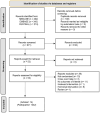Pharmacological non-hormonal treatment options for male infertility: a systematic review and network meta-analysis
- PMID: 39075435
- PMCID: PMC11285325
- DOI: 10.1186/s12894-024-01545-1
Pharmacological non-hormonal treatment options for male infertility: a systematic review and network meta-analysis
Erratum in
-
Correction: Pharmacological non-hormonal treatment options for male infertility: a systematic review and network meta-analysis.BMC Urol. 2025 Jul 18;25(1):174. doi: 10.1186/s12894-025-01874-9. BMC Urol. 2025. PMID: 40682026 Free PMC article. No abstract available.
Abstract
Background: Male factor infertility affect up to 50% of couples unable to conceive spontaneously. Several non-hormonal pharmacological treatments have been proposed to boost spermatogenesis and increase chances of conception in men with infertility. Still, no clear evidence exists on the most effective treatment strategy.
Objective: We aimed to compare the effectiveness of non-hormonal pharmacological treatment options for men with infertility using a systematic review and network meta-analysis.
Methods: We searched MEDLINE, EMBASE, and CENTRAL until October 2023 for randomised/quasi-randomised trials that evaluated any non-hormonal pharmacological treatment options for men with idiopathic semen abnormalities or those with hypogonadism. We performed pairwise and network meta-analyses using a random effect model. We assessed risk of bias, heterogeneity, and network inconsistency. We calculated the mean rank and the surface under the cumulative ranking curve (SUCRA) for each intervention the maximum likelihood to achieve each of reported outcomes. We reported primarily on sperm concentration and other important semen and biochemical outcomes using standardised mean difference (SMD) and 95% confidence-intervals(CI).
Results: We included 14 randomised trials evaluating four treatments (Clomiphene citrate, Tamoxifen, Aromatase inhibitors, anti-oxidants) and their combinations in 1342 men. The overall quality of included trials was low. Sperm concentration improved with clomiphene compared to anti-oxidants (SMD 2.15, 95%CI 0.78-3.52), aromatase inhibitor (SMD 2.93, 95%CI 1.23-4.62), tamoxifen (SMD - 1.96, 95%CI -3.57; -0.36) but not compared to placebo (SMD - 1.53, 95%CI -3.52- 0.47). Clomiphene had the highest likelihood to achieve the maximum change in sperm concentration (SUCRA 97.4). All treatments showed similar effect for sperm motility, semen volume, and normal sperm morphology. FSH levels showed significant improvement with clomiphene vs.anti-oxidant (SMD 1.48, 95%CI 0.44-2.51) but not compared to placebo. The evidence networks for LH and testosterone suffered from significant inconsistency (p = 0.01) with similar trend of improvement with clomiphene compared to other treatments but not compared to placebo.
Conclusion: There is insufficient evidence to support the routine use of Clomiphene, tamoxifen, and aromatase inhibitors to optimise semen parameters in men with infertility. Future randomised trials are needed to confirm the efficacy of clomiphene in improving fertility outcomes in men.
Prospero: CRD42023430179.
Keywords: Anastrozole; Clomiphene; Letrozole; Male infertility; Network meta-analysis; Oligospermia; Randomised trials; Systematic review; Tamoxifen.
© 2024. The Author(s).
Conflict of interest statement
The authors declare no competing interests.
Figures




References
-
- Choy JT, Eisenberg ML. Male infertility as a window to health. Fertil Steril. 2018;110(5):810–4. - PubMed
-
- Sexual and Reproductive Health - INTRODUCTION. - Uroweb [Internet]. [cited 2023 Oct 31]. https://uroweb.org/guidelines/sexual-and-reproductive-health.
Publication types
MeSH terms
Substances
LinkOut - more resources
Full Text Sources
Medical

